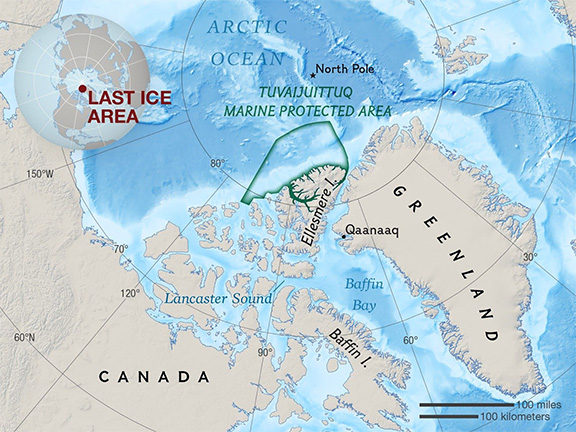Biodiversity & Environment
Melting of Arctic’s ‘Last Ice Area’
- 05 Jul 2021
- 4 min read
Why in News
The ‘Last Ice Area’ (LIA), located in the Arctic’s Ice north of Greenland, has started melting earlier than what the scientists had expected.
Key Points
- Last Ice Area:
- This region is located north of Greenland and Ellesmere Island in the Canadian territory of Nunavut.
- This area was believed to be strong enough to withstand global warming.
- The total disappearance of summer ice in the Arctic was estimated by the year 2040, however the 'Last Ice Area’ was the exception.
- World Wildlife Fund (WWF)-Canada was believed to be the first to call this area the 'Last Ice Area’.
- Importance:
- It was thought to be able to help ice-dependent species as ice in the surrounding areas melted away.
- It is used by polar bears to hunt for seals who use ice to build dens for their offspring. Walruses too, use the surface of the ice for foraging (to search for food).
- Sea ice is a highway for inuit, who use it to travel and hunt.
- The term Inuit refers broadly to the Arctic indigenous population of Alaska, Canada, and Greenland.
- Reasons for Melting:
- About 80% of thinning can be attributed to weather-related factors such as winds that break up and move the ice around.
- The remaining 20% can be attributed to longer-term thinning of the ice due to global warming.
- About Arctic:
- The Arctic is a polar region located at the northernmost part of Earth.
- The Arctic consists of the Arctic Ocean, adjacent seas, and parts of Alaska (United States), Canada, Finland, Greenland (Denmark), Iceland, Norway, Russia, and Sweden.
- Land within the Arctic region has seasonally varying snow and ice cover.
- Since 2013, India has had observer status in the Arctic Council, which is the predominant inter-governmental forum for cooperation on the environmental and development aspects of the Arctic.
- Impact of Melting Arctic Ice:
- Global Climate: The Arctic and Antarctic act like the world’s refrigerator. Since they are covered in white snow and ice that reflect heat back into space (Albedo effect), they balance out other parts of the world that absorb heat.
- Coastal Communities: Global average sea level has risen by about 7-8 inches since 1900, and it’s getting worse. Rising seas endanger coastal cities and small island nations by exacerbating coastal flooding and storm surge.
- Food Security: Polar vortexes, increased heat waves, and unpredictability of weather caused by ice loss are already causing significant damage to crops on which global food systems depend.
- Permafrost & Global Warming: Permafrost in the Arctic region (ground that is permanently frozen) stores large amounts of methane, which is a greenhouse gas that contributes to climate change.
- Biodiversity Threat: Melting of the Arctic ice puts the Arctic region’s vibrant biodiversity under serious threat.
- India’s interests in Arctic:
- Recently, India participated in the 3rd Arctic Science Ministerial (ASM) and shared plans for research and long-term cooperation in the Arctic Region.





